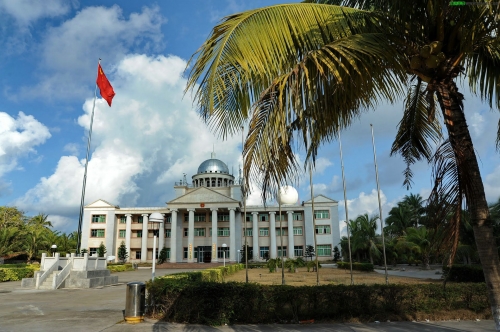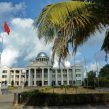
Sansha: New City in the South China Sea
Publication: China Brief Volume: 12 Issue: 16
By:

In late July 2012, Beijing officially established a new city, Sansha, literally “three sands” or “three sandbanks” (Xinhua, July 24). The name carried well-thought out symbolism, since the new city was to have jurisdiction over the Paracel Islands (xisha qundao, western sands archipelago), the Spratly Islands (nansha qundao, southern sands archipelago) and Macclesfield Bank (zhongsha qundao, middle sands archipelago) [1]. Although the proximate reason for Sansha’s establishment was Vietnam’s enacting legislation claiming jurisdiction over the Paracels and Spratlys, official sources stated the central government had been considering this option for 20 years (Global Times, July 24). Reportedly, the idea was seriously considered five years ago, but Beijing decided to wait to account for the interests of all the parties. In the face of other countries’ predations, however, China had no choice but to take this “passive response” (China National Radio, August 10). While ostensibly defensive, Sansha’s establishment solidifies Beijing’s claims at a time when regional players are uncoordinated and unable to challenge Chinese actions effectively.
The origins of Sansha and Beijing’s 20-year consideration of it presumably stem from 1992 legislation by the National People’s Congress that unilaterally declared Chinese sovereignty over not only the aforementioned islands but over Taiwan, the Pratas Islands (dongsha qundao) and the Japanese-administered Diaoyu Islands (also known as the Senkaku Islands). All have at least one other claimant. The same law, though providing for the right of innocent passage for non-military vessels, gave China broad rights over what it referred to as its territorial sea as well as the airspace over and seabed and subsoil under it [2]. China bases its claims in this area on a so-called U-shaped line, sometimes known as the cow’s tongue or nine-dotted line, which first appeared in 1914 and, hence, long predates the founding of the People’s Republic in 1949 [3]. Some analysts believe, although China claims all the features within the area and the associated exclusive economic zones (EEZs), it does not see the waters within the lines as territorial waters (Straits Times, July 23).
Despite causing considerable consternation at the time, the law was but lightly and sporadically enforced until recently. Factors that have changed this situation include increased competition for energy resources that enhanced the value of the oil and gas resources that the East and South China seas are believed to contain; dwindling world supplies of fish that enhanced the value of the rich fishing grounds of the area, and China’s rapidly growing economic and military strength that made enforcement of Beijing’s claims seem more feasible. Though differences of opinion exist over the precise wording of recent statements and whether they were made in an official or an unofficial capacity, it appears to some regional observers that Beijing has claimed jurisdiction over both the East China and South China seas (The Pioneer [India], August 3; Yomiuri Shimbun, July 26).
Certainly there is no doubt that in both words and deeds, Beijing has become more assertive: the Chinese foreign minister told Southeast Asian foreign ministers in the summer of 2010 that they would have to understand that China was a big country while they were small. (Wall Street Journal, October 1, 2010). In September, after the Japanese arrested a Chinese fishing boat captain whose vessel had rammed two Japanese Coast Guard ships, Beijing announced an embargo on rare earth shipments to Japan, subjected its imports to an excruciatingly slow inspection procedure, and discouraged tourism to the country. The captain was quickly and humiliatingly released, returning home to a hero’s welcome. Beijing announced henceforth its ships would patrol the waters, which they have done.
In mid-2012, as four ships of the Indian Navy departed the Philippines for South Korea, a Chinese People’s Liberation Army naval ship radioed “Welcome to the South China Sea,” and escorted the Indian ships through the area. This seemed to indicate China does regard the area as within its territorial waters and, according to sources in New Delhi, clear evidence that Beijing perceives India as a factor in the South China Sea dispute (Daily News and Analysis [India], June 25).
Sansha Municipality’s founding represents a step forward in this more assertive posture. The city’s top priority is described as safeguarding the nation’s sovereignty over the area’s islands and waters. Expelling foreign vessels that intrude into China’s territorial waters and air space will be daily tasks for the military garrison to be stationed there. A commentator for the Global Times explicitly described the formation of the new city and its military garrison as a departure from Beijing’s past policy of refraining from the use of military force to protect its sovereignty and “a new challenge for China. Hence, the focus on economic development that is the priority of most other Chinese cities is not appropriate, and it should be treated differently in terms of the assessment of its future achievements” (Global Times, July 24).
Most recent instances of confrontation have concerned Vietnam and the Philippines. Beginning in mid-decade, all parties began to unilaterally drill in disputed areas, prompting Beijing to increase its presence around the Paracels and Spratly islands, and each to accuse the others of violating the 2002 ASEAN Code of Conduct on the South China Sea (Xinhua, August 4) [4]. In mid-2011 Manila discovered Chinese ships had erected boundary posts near Reed Bank, within the Philippines’ EEZ. Several more incidents followed, amid charges and countercharges. The latest recurrence was a two-month confrontation that began in April 2012 near Scarborough Shoal, north of the Spratlys. Beijing responded to Manila’s demands to withdraw its ships by prohibiting the import of Philippine bananas, impacting a $75 million market on which 200,000 jobs depend, and following that up with a ban on the countries’ pineapples and papayas as well. After both sides briefly withdrew their vessels, Chinese fishing boats returned escorted by a Chinese Maritime Surveillance ship (Associated Press, June 28).
Almost immediately thereafter, the China National Offshore Oil Corporation (CNOOC) announced it was accepting bids for a new batch of oil-exploration blocks that are entirely within Vietnam’s EEZ as stipulated in the United Nations Convention on the Law of the Sea (Wall Street Journal, June 28). Hanoi issued a formal objection and demanded CNOOC cancel the offering. Immediately thereafter, state-owned PetroVietnam urged foreign firms to not get involved. Beijing retorted that CNOOC’s action represented normal business activities consonant with both Chinese and international law. Since it is unlikely that foreign firms will choose to invest assets in so contentious an area—nor could CNOOC have entertained any notion that they would do so—a more plausible explanation would seem to be that Beijing is using the company to press its claims in the area.
With ASEAN in disarray after a contentious meeting of foreign ministers that, for the first time in the organization’s history failed to produce a communiqué, Beijing need not be concerned with united resistance from Southeast Asia, leaving the field essentially clear for it to move forward. (“China Pushes on the South China Sea, ASEAN Unity Collapses,” China Brief, August 4). Beijing seems sufficiently concerned with the possibility of U.S. intervention to issue repeated warnings against it. China reacted sharply against U.S. Secretary of State Hillary Clinton’s statement that competing claims over South China Sea island chains should be resolved without coercion or threat, terming them an “attack” on China (Ministry of Foreign Affairs, July 24, 2010). More recently, after a State Department spokesperson made a similar statement reiterating that the United States does not take a position on competing territorial claims and has no territorial ambitions in the South China Sea (U.S. State Department, August 3), Beijing summoned the U.S. Embassy’s Deputy Chief of Mission to make “serious representations” that emphasized China’s absolute sovereignty over the area and that it would countenance no interference in its right to establish Sansha and its garrison (Xinhua, August 5; Reuters, August 5). Other commentaries admonished the United States to “behave itself” rather than using the dispute to “drive a wedge between China and its neighbors so as to clip China’s wings and shore up the United States’ cracking pedestal in the Asia-Pacific” (China National Radio, August 10; Xinhua, August 4, 2012). Elsewhere, the United States’ “cracking pedestal” was linked to a resentment indicative of the country’s decline (People’s Daily, August 7). More ominous was a Global Times article that argued China was “challenged by many other international issues such as the Diaoyu Islands dispute, that will require a new understanding of international rules. Learning what rules the outside world really plays by should be one of the main goals of our participation in the London Games” (Global Times, August 7).
Beijing’s fears aside, there is little possibility of U.S. intervention. There is opposition both within the region and in the United States about the wisdom of allowing the South China Sea to become a battleground for great power rivalries. In apparent disregard of the economic issues involved, some groups in Southeast Asia seem to regard their countries as innocent bystanders, who have no stake in a conflict between great power elephants. Similarly, some Americans regard the South China Sea as irrelevant to U.S. national interests and caution against being drawn into yet another entangling alliance. For now, the protests have abated, and other news stories have displaced it in the media even if the contradictions remain unresolved.
Suggestions for joint development of the contested areas are unrealistic. Inflamed domestic public opinion among all claimants means that the granting of even minor concessions is potentially suicidal to the political career of democratically-elected politicians and worrisome even in authoritarian governments like China, whose leadership appears fixated on the need to safeguard what is euphemistically referred to as social stability. Moreover, until the claimants can agree on the size of the maritime zones surrounding their claims—which after repeated efforts they have been unable to accomplish—negotiating joint development is impossible.
In conclusion, protests aside, China will have a largely free hand in the South China Sea. It will garrison the area from Sansha as it has vowed to do. This will be no small task. The island has no water apart from what little rain can be collected in barrels; the rest is delivered by freighter from Hainan, the province that administers the city. Ships must navigate a thirteen- to fifteen- hour voyage among dangerous reefs. The first soldiers there attempted to plant crops and raise chickens, but found them devoured by the local rat population. Cats imported to take care of the rats proved no match for the rodents. Even today, most food must, like water, be supplied from outside. An infrastructure will have to be created to house the garrison. Given Beijing’s demonstrated determination to solidify its claims to the South China Sea and the weakness of its opposition, there can be little doubt that China will succeed in doing do, Its salami tactics have proved stunningly successful so far. Beijing has little reason to compromise, making future incidents probable.
Notes:
- Macclesfield is actually a series of submerged coral reefs and shoals and hence an atoll rather than a true island. It is located east of the Paracels and north of the Spratlys.
- Law on the Territorial Sea and the Contiguous Zone, People’s Republic of China, February 25, 1992, Available online at https://www.un.org/Depts/los/LEGISLATIONANDTREATIES/STATEFILES/CHN.htm
- Zou Keyuan, “China’s U-Shaped Line in the South China Sea Revisited,” Ocean Development and International Law, Vol. 43, No. 1, 2012, pp. 18–34.
- Under which the signatories agreed to exercise self-restraint in the conduct of activities that would complicate or escalate disputes, and to hold dialogues as appropriate. https://www.aseansec.org/13163.htm . For the Filipino view, see (no author) “China Violated 2002 ASEAN Declaration of Conduct by Constructing Posts in the Reed Bank, Near Spratly Philippines,” https://betterphils.blogspot.com/2011/06/china-violated-2002-asean-declaration.html.





